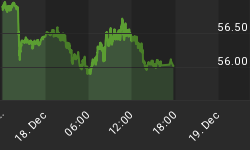The Federal Reserve has raised interest rates by a quarter-point—or 25 basis points--in a move widely expected by the market, despite the fact that it puts rates at their highest levels in 10 years.
It was the first rate hike imposed by new Fed Chairman Jerome Powell, and it sets rate targets at 1.5 percent to 1.75 percent, which in turn will likely result in an increase in consumer interest rates.
But what may concern the market is the Fed’s economic forecast, which raises the 2017 GDP growth forecast from 2.5 percent to 2.7 percent. It also raised the 2018 forecast from 2.1 percent to 2.4 percent, dropping down only in 2020.
In February, in his debut appearance, Powell spooked the markets when he said that headwinds had turned into tailwinds, and the U.S. economy was strengthening. That was code for potentially more interest rate hikes than the three that are already on the books for this year.
Wall Street, however, seems to have already priced in a fourth rate hike, so the spook-effect has been dulled.
Stocks were up ahead of the Fed announcement, and had already anticipated the rate hike. Related: Spending Bill Could Cause U.S. Debt To Soar To 99% Of GDP
The Dow gained ahead of the rate-hike decision, and was still up afterwards.

(Click to enlarge)
In fact, the Dow briefly traded 250 points higher ahead of the Fed decision, while the S&P 500 gained 0.5 percent, with energy rising nearly 3 percent. Financials also jumped to trade 0.8 percent higher.
Right after the rate hike announcement, the Nasdaq gained 0.6 percent, while the S&P gained 0.8 percent.
The Fed’s inflation expectations were largely unchanged from earlier, calling 1.9 percent for core inflation (excluding food and energy prices) and headline inflation. This is despite the fed’s expectations of even lower unemployment—a situation which typically results in higher inflation.
In a statement, the Fed said the “economic outlook has strengthened in recent months”, which would have been vague enough to jolt the market a month ago, but not today.
Randy Anderson, chief economist at Griffin Capital, told CNBC that Powell “delivered what the market was expecting, albeit with a more hawkish tone.” Related: What Should Gold Investors Expect From The New Fed Chair?
“I think they’ve overstated the economic strength for 2019. What they’re doing is looking in the rearview mirror to the Trump administration’s tax and infrastructure policies, which can boost GDP in the short term, but can also lead to increases in debt and deficits. Those can put a short circuit in the economy,” he said.
Consumers, though, should be getting ready for higher borrowing costs.
“The average American is going to see a little bit of a pinch,” Steve Rick, chief economist of CUNA Mutual Group, told USA Today. Rick said applications for some mortgages and auto loans have picked up in recent weeks as consumers attempted to get rates locked in ahead of the hike.
Auto loans are not expected to be hit as hard as credit card rates, adjustable-rate mortgages and HELOCs, because of the competitive pressure in this industry. Conventional 30-year mortgages are also expected to see only a mild rate hike as a result of the Fed’s decision.
By David Craggen for Safehaven.com
More Top Reads From Safehaven.com:
















